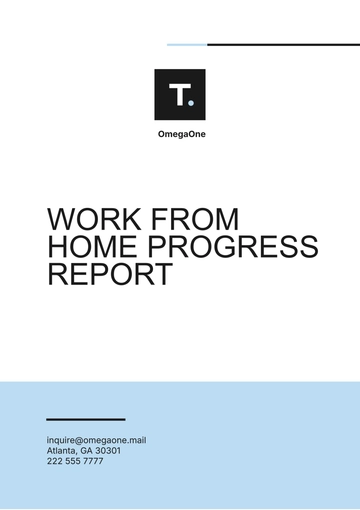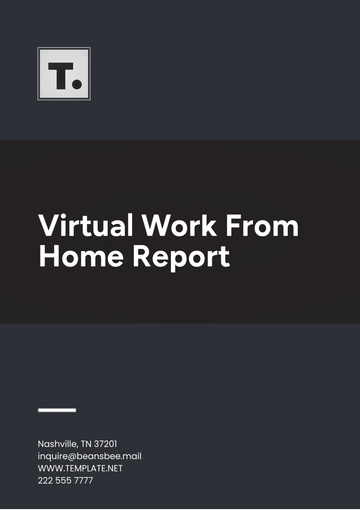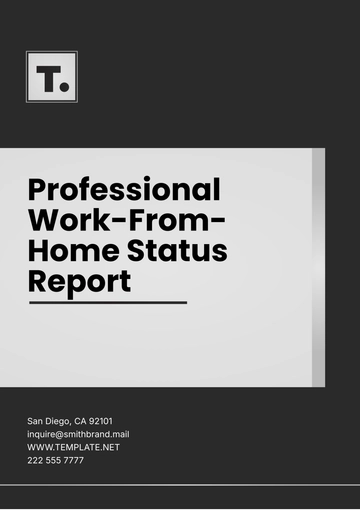Free Work From Home Incident Report

I. Introduction
This report provides a comprehensive analysis of the incident that occurred while the employee was working remotely on September 15, 2050. It includes a thorough overview of the incident, immediate corrective actions taken, a root cause analysis, and detailed recommendations to prevent similar occurrences in the future. The goal of this report is to mitigate future risks and enhance the organization's remote work infrastructure and protocols.
II. Incident Overview
1. Incident Description
On September 15, 2050, Trace Durgan, while performing work duties remotely, encountered a critical issue that led to a significant disruption. The nature of the incident involved a cybersecurity breach. Specifically, Trace unknowingly downloaded a malicious file while accessing an unsecured website during a research project, compromising sensitive company data.
2. Immediate Actions Taken
To address the incident promptly, the following actions were taken:
Notification to the IT Department: The IT team was alerted immediately to resolve technical issues and investigate any potential breaches or malfunctions.
Emergency Services Contacted: No health-related incidents required emergency services, but the employee was advised to seek medical attention for stress-related symptoms.
Data Security Measures: Sensitive data, including client information, was secured to prevent further compromise and limit the scope of the breach.
Employee Communication: Jane was contacted to gather initial insights, assess her well-being, and understand the sequence of events that led to the incident.
III. Detailed Analysis
1. Root Cause Analysis
The root causes of the incident were identified through a detailed investigation. The table below outlines the primary causes contributing to the issue:
Root Cause | Description |
|---|---|
Technical Failure | A technical malfunction occurred due to outdated antivirus software that failed to detect the malicious file, creating vulnerabilities that led to the data breach. |
User Error | Trace inadvertently downloaded a file labeled “Important_Company_Updates.exe” from an unsecured website, which led to the unauthorized access of sensitive information and compromised the security of the system. |
Environmental Factors | Trace’s home office setup was not ergonomically sound, contributing to a repetitive stress injury from prolonged sitting and an improper workstation arrangement. |
2. Impact Assessment
The incident had the following significant effects on the organization and the employees:
Data Integrity: Sensitive company and client data were exposed because of the breach, leading to potential legal and reputational risks associated with privacy violations.
Operational Downtime: Trace could not perform her work duties for two days because of system recovery efforts and necessary investigations by the IT department.
Health and Safety: Trace suffered from a repetitive stress injury, requiring medical attention and resulting in a two-week recovery period, affecting her overall productivity.
IV. Recommendations
1. Preventive Measures
Based on the findings, the following immediate actions are recommended to prevent future incidents:
Regular System Updates and Maintenance: Ensure that all systems are routinely updated with the latest antivirus software and security patches to reduce technical vulnerabilities.
Employee Training on Phishing and Cybersecurity: Conduct quarterly training sessions to raise awareness about phishing attacks, malware, and best practices for handling potentially malicious content.
Home Office Ergonomic Assessments: Provide ergonomic assessments and support for employees working remotely to ensure their workspace is safe and conducive to long-term productivity.
Two-Factor Authentication (2FA): Enforce 2FA for all systems handling sensitive data to enhance security and prevent unauthorized access.
2. Long-term Strategies
In addition to immediate preventive measures, the following long-term strategies are recommended:
Continuous System Monitoring: Implement continuous monitoring tools to detect and respond to potential system anomalies and breaches in real time, minimizing downtime and exposure.
Enhanced Cybersecurity Protocols: Strengthen overall cybersecurity infrastructure by adopting advanced encryption methods, multi-layered defense mechanisms, and periodic security audits.
Work-from-Home Support Programs: Introduce comprehensive remote work support programs that include ergonomic consultations, health and wellness resources, and technical support to maintain employee well-being and productivity.
V. Conclusion
The incident underscores the critical importance of maintaining a secure and supportive remote work environment. By implementing the recommended preventive measures and long-term strategies, the organization can significantly reduce the risks associated with remote working. A holistic approach that integrates technical safeguards, employee education, and ergonomic considerations will ensure that both company assets and employee health are protected, leading to a safer, more productive remote work experience for all staff members.
- 100% Customizable, free editor
- Access 1 Million+ Templates, photo’s & graphics
- Download or share as a template
- Click and replace photos, graphics, text, backgrounds
- Resize, crop, AI write & more
- Access advanced editor
Stay organized and efficient with Template.net's Work From Home Incident Report Template. This fully customizable and editable template allows you to track and report incidents seamlessly. Editable in our Ai Editor Tool, it offers flexibility for quick adjustments, ensuring your reports are professional and accurate every time. Perfect for remote work environments.
You may also like
- Sales Report
- Daily Report
- Project Report
- Business Report
- Weekly Report
- Incident Report
- Annual Report
- Report Layout
- Report Design
- Progress Report
- Marketing Report
- Company Report
- Monthly Report
- Audit Report
- Status Report
- School Report
- Reports Hr
- Management Report
- Project Status Report
- Handover Report
- Health And Safety Report
- Restaurant Report
- Construction Report
- Research Report
- Evaluation Report
- Investigation Report
- Employee Report
- Advertising Report
- Weekly Status Report
- Project Management Report
- Finance Report
- Service Report
- Technical Report
- Meeting Report
- Quarterly Report
- Inspection Report
- Medical Report
- Test Report
- Summary Report
- Inventory Report
- Valuation Report
- Operations Report
- Payroll Report
- Training Report
- Job Report
- Case Report
- Performance Report
- Board Report
- Internal Audit Report
- Student Report
- Monthly Management Report
- Small Business Report
- Accident Report
- Call Center Report
- Activity Report
- IT and Software Report
- Internship Report
- Visit Report
- Product Report
- Book Report
- Property Report
- Recruitment Report
- University Report
- Event Report
- SEO Report
- Conference Report
- Narrative Report
- Nursing Home Report
- Preschool Report
- Call Report
- Customer Report
- Employee Incident Report
- Accomplishment Report
- Social Media Report
- Work From Home Report
- Security Report
- Damage Report
- Quality Report
- Internal Report
- Nurse Report
- Real Estate Report
- Hotel Report
- Equipment Report
- Credit Report
- Field Report
- Non Profit Report
- Maintenance Report
- News Report
- Survey Report
- Executive Report
- Law Firm Report
- Advertising Agency Report
- Interior Design Report
- Travel Agency Report
- Stock Report
- Salon Report
- Bug Report
- Workplace Report
- Action Report
- Investor Report
- Cleaning Services Report
- Consulting Report
- Freelancer Report
- Site Visit Report
- Trip Report
- Classroom Observation Report
- Vehicle Report
- Final Report
- Software Report



















